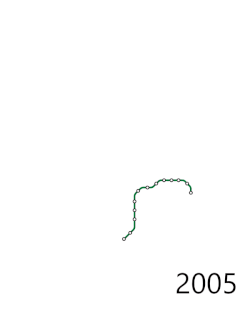This article needs to be updated.(January 2025) |
| Chongqing Rail Transit | |||
|---|---|---|---|
| | |||
 | |||
| Overview | |||
| Native name | 重庆轨道交通 | ||
| Owner | Chongqing City Transportation Development & Investment (Group) Co., Ltd. | ||
| Area served | Chongqing Urban Area | ||
| Locale | Chongqing, China | ||
| Transit type | | ||
| Number of lines | 12 | ||
| Number of stations | 316 | ||
| Daily ridership | 3.005 million (2021 avg) [1] 4.169 million (peak on 30 April 2021) [2] | ||
| Annual ridership | 1.097 billion (2021) [1] | ||
| Chief executive | Le Mei | ||
| Headquarters | 123 Renmin Rd., Yuzhong District, Chongqing | ||
| Website | http://www.cqmetro.cn | ||
| Operation | |||
| Began operation | 6 November 2004 (trial) 18 June 2005 (officially) | ||
| Operator(s) | Chongqing Rail Transit (Group) Co., Ltd. | ||
| Number of vehicles | 274 [3] | ||
| Headway | 2.5 min to 12 min [3] | ||
| Technical | |||
| System length | 568.87 km (353.48 mi) [a] [4] | ||
| Track gauge | | ||
| Electrification | | ||
| Average speed | | ||
| Top speed | | ||
| |||
| Chongqing Rail Transit | |||||||||||
|---|---|---|---|---|---|---|---|---|---|---|---|
| Simplified Chinese | 重庆轨道交通 | ||||||||||
| Traditional Chinese | 重慶軌道交通 | ||||||||||
| |||||||||||
The Chongqing Rail Transit (branded as CRT;also known as Chongqing Metro) is the rapid transit system in the city of Chongqing,China. In operation since 2005,it serves the transportation needs of the city's main business and entertainment areas in downtown as well as the inner suburbs. As of December 2023 [update] ,CRT consists of twelve lines with a total track length of 561.18 km (349 mi). [4] Lines 1,4,5,6,9,10,18,the Loop line,Jiangtiao line,and Bitong line are conventional heavy-rail metro lines,while Lines 2 and 3 are high-capacity monorails. To keep up with urban growth,construction on several other lines is under way.
Contents
- Network
- Loop line (Line 0)
- Line 1
- Line 2
- Line 3
- Line 4
- Line 5
- Line 6
- Line 9
- Line 10
- Line 18
- Jiangtiao line
- Bitong line
- Ticketing
- Transport cards
- Time limit
- Operation
- Accessibility
- Luggage rack
- History
- Early concepts and attempts
- Official long-term plans
- Commencement and expansions
- Incidents
- Technology
- Visual design
- Expansion
- Phase 4 projects
- See also
- References
- Notes
- External links
The Chongqing Rail Transit is a unique transit system owing to the nature of Chongqing being a densely populated yet mountainous city with multiple river valleys. Two lines use heavy-monorail technology,leveraging the ability to negotiate steep grades and tight curves and rapid transit capacity. They are capable of transporting 32,000 passengers per hour per direction. [5] However the busiest section of Line 3 reaches a peak passenger volume of 37,700 pphpd[ clarification needed ][ clarification needed ] in 2019. [6] At 98 km (61 mi), [7] the system's two monorail lines form the longest monorail system in the world, [8] with Line 3 being the world's longest single monorail line. [9] [10] The length and the capacity of its monorail network both also make it the world's busiest monorail system,with a total of 94 million and 250 million rides in 2015 on Line 2 and Line 3,respectively. [11] Line 3 is therefore the world's busiest single monorail line.
The extreme difference in elevation between the river valleys and the hilly plateaus of Chongqing poses a unique challenge in designing alignments for conventional rail transit lines. The network currently has the world's highest metro-only bridge,the Caijia Rail Transit Bridge of Line 6 spanning the Jialing River valley,with the bridge deck being approximately 100 m (328 ft) above the water. [12] It also boasts the three deepest metro stations in China:Hongyancun (the deepest in the world),Hongtudi,and Liyuchi. Additionally,Hualongqiao is a six-story structure that has Line 9 trains stopping 48 meters above the surface, [13] [14] making it the tallest metro station in the world,surpassing Smith–Ninth Streets station in New York.
The Chongqing Rail Transit system possesses a number of extremely-long metro-only bridges. The 1,650 m (5,413 ft) long Egongyan Rail Transit Bridge carries the southern arc of the Loop line across the Yangtze River using a 600 m (1,969 ft) long suspension main span,making it the longest metro-only suspension bridge by main span in the world. [15] The Nanjimen Bridge carries Line 10 trains across a 1,225 m (4,019 ft) cable-stayed bridge with a main span of 480 m (1,575 ft),making it the longest metro-only cable-stayed bridge by main span in the world. [16] The Gaojia Huayuan Jialing River Rail Transit Bridge carries the western arc of the Loop line over the Jialing River using a long 594 m (1,949 ft) bridge with a main span of 340 m (1,115 ft). [17] Additionally,Chongqing Rail Transit system has numerous double-deck bridges carrying vehicle and metro traffic,such as the Chaotianmen Bridge,which is the world's longest arch bridge.


































